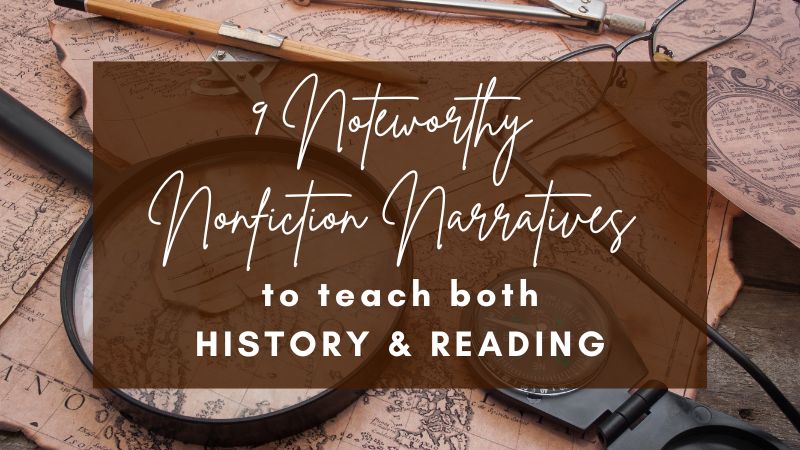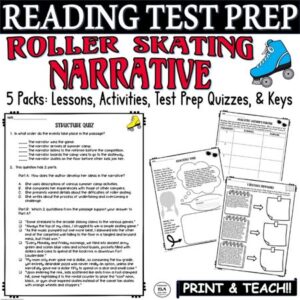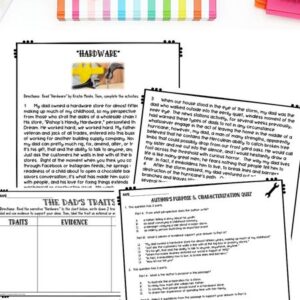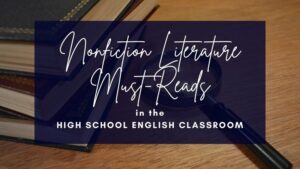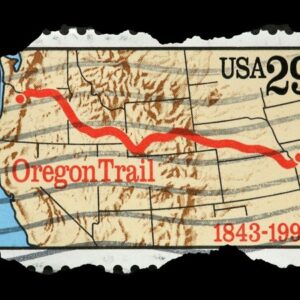I have been learning a lot about teaching reading lately, particularly from Natalie Wexler’s The Knowledge Gap. As I finish this fantastic read, I am continually thinking about ways to include real and relevant texts like historical sources, nonfiction narrative passages, scientific articles, and other content-heavy, knowledge-focused pieces of writing!
And more than anything, I am blown away by what I knew intuitively about teaching students how to read effectively but could not put into precise enough words. Her call to focus on phonics instruction, vocabulary, and content in the early grades is a message that ALL teachers, administrators, and parents should hear loudly and clearly.
If you need help starting this journey in your Reading or English classroom, I would encourage you to start with nonfiction narrative texts. Because we all thrive on stories and like to hear what’s going on in our families, our neighborhoods, and our country, beginning with these nonfiction narrative passages makes total sense.
Plus, most of these narratives are not super popular, so you can give your students new options and perspectives as a part of your curriculum!
Keep reading for 9 Noteworthy Nonfiction Narrative Passages you can use in your Secondary English Classroom!
Need help with Test Prep? Check out this FREE Pack of 3 Test Prep Activities to help students achieve success on standardized tests!
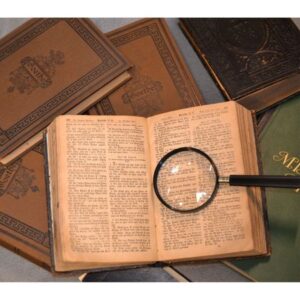
Why teach nonfiction narrative texts?
Ultimately, I enjoy teaching nonfiction narrative texts because…
- They are shorter than whole novels.
- I can pick and choose certain excerpts.
- They offer a real view of a historical period.
- I can link major ideas and themes with fiction.
- They usually include higher-level vocabulary than many stories nowadays.
- They tell a story of a specific, focused event.
Really, I want to include more rich, content-filled literature, and my foray into this traditional approach will more easily help my students transition with the use of nonfiction narrative passages!
9 Noteworthy Nonfiction Narrative Passages
1. “Roller Skating” by Kristin Menke
This 700-word nonfiction narrative “Roller Skating” tells the story of a summer camp girl in 1990s South Florida, a memorial to a different time. The fun and engaging language as well as the real-life situation will readily appeal to your 7th-10th grade students!
Here are the first several paragraphs of this nonfiction narrative:
In the summer of 1992, I attended Camp McGinnis in South Florida, a camp that personifies the utter perfection of the idyllic camp experience, at least to a kid in the 90’s. Every week, the counselors painted this wonderfully consistent tapestry with strings made of roller skating, waterskiing, and jungle gyms transforming the schedule into a sort of thick weave, creating the foundation for such a child’s utopic dream.
Every Monday and Friday mornings, we filed into ancient army green and ocean blue vans and school buses, pockets filled with dollars and coins to spend at the local rink in downtown Fort Lauderdale. I can still smell the berry bubble gum, a musty perfume from days spent at the lake, and years of child sweat embedded into the pleather seats.
Even in South Florida, air conditioning did not exist for the summer camp child. It’s not that we didn’t notice; it’s that we didn’t care. Summer embeds itself into you primarily through the skin, and somehow, we knew it was a necessary part of every journey.
Want the whole story with reading comprehension activities? Click HERE!
2. “Hardware” by Kristin Menke
Supernatural events are a regular part of life. The Midwest has tornados. The extreme West has earthquakes. The Northeast has heavy snow. The South, oh the South, has flooding, hurricanes, and extreme heat!
The nonfiction narrative “Hardware” describes a true story of a hurricane experienced through the eyes of a child. It doesn’t take very long to read, and you can include SO MANY other texts and articles centered around weather events across the nation!
Here is the first part of this nonfiction narrative:
1 My dad owned a hardware store for almost fifteen years, making up much of my childhood, so my perspective is a bit different from those who stroll the aisles of a wholesale chain hardware store. His store, “Bishop’s Handy Hardware,” personified the American Dream. He worked hard; we worked hard.
My father, a military veteran and jack of all trades, entered into this business after years of working for another building supply company. Now let me tell you: my dad can pretty much rig, fix, amend, alter, or transform anything. It’s his gift, that and the ability to talk to anyone, anywhere, anytime. Just ask the customers he waits in line with at the big box or grocery stores.
Right at the moment when you think you can mindlessly float through Facebook or Instagram feeds; he springs upon you with the readiness of a child about to open a chocolate bar. My dad simply savors conversation; it’s what has made him successful.
He connects with people, and his love for fixing things extends beyond a mere mechanical or construction issue. He wants to solve all of the problems of the world, both inside and outside of the hardware store.
To finish the story, keep reading HERE!
3. Roughing It by Mark Twain
Inserting a bit of the Everyman experience from the 1800s, Mark Twain’s writing offers more than satire or fictional passages about children. Roughing It depicts Twain’s own memories of traveling throughout the United States!
Here is an excerpt from this riveting nonfiction narrative:
At the end of an hour or two I was ready for the journey. Not much packing up was necessary, because we were going in the overland stage from the Missouri frontier to Nevada, and passengers were only allowed a small quantity of baggage apiece. There was no Pacific railroad in those fine times of ten or twelve years ago—¬not a single rail of it.
I only proposed to stay in Nevada three months—¬I had no thought of staying longer than that. I meant to see all I could that was new and strange, and then hurry home to business. I little thought that I would not see the end of that three-month pleasure excursion for six or seven uncommonly long years!
Crave more ideas for teaching nonfiction? Click to read “12 Nonfiction Literature Must Reads in the High School English Classroom!“
4. Life on the Mississippi by Mark Twain
Although this book by Mark Twain is not filled with harrowing adventures, it does describe an important time in our country’s history. The Mississippi River played, and still plays, an important part in commerce, population growth, and movement throughout the nation!
Here is an excerpt from this nonfiction narrative:
It is a remarkable river in this: that instead of widening toward its mouth, it grows narrower; grows narrower and deeper. From the junction of the Ohio to a point halfway down to the sea, the width averages a mile in high water: thence to the sea the width steadily diminishes, until, at the ‘Passes,’ above the mouth, it is but little over half a mile.
At the junction of the Ohio the Mississippi’s depth is eighty-seven feet; the depth increases gradually, reaching one hundred and twenty-nine just above the mouth.
Check out these comprehension questions to help your students master this knowledge and boost their reading skills!
5. “Taking the Trail for Oregon” from the book Ox Team Days on the Oregon Trail
I grew up in the Oregon Trail computer game era, so I consider myself a verifiable EXPERT on this time period…okay, maybe I have a passing knowledge of this time in history.
Unfortunately, many of our students don’t know ANYTHING about the Oregon Trail and Westward expansion. “Taking the Trail” from the book Ox Team Days on the Oregon Trail helps students understand this historical period with a real-life nonfiction narrative!
Here are 3 paragraphs from this nonfiction narrative:
WHEN we drove out of Eddyville, headed for the Oregon Country, our train consisted of but one wagon, two yoke of four-year old steers, and one yoke of cows. We also had one extra cow. This cow was the only animal we lost on the whole journey; she strayed away in the river bottom before we crossed the Missouri.
Now as to the members of our little party. William Buck, who had joined us as partner for the expedition, was a man six years my senior. He had had some experience on the Plains, and he knew what outfit was needed; but he had little knowledge in regard to a team of cattle. He was an impulsive man, and to some extent excitable; yet withal a man of excellent judgment and honest as God makes men.
No lazy bones occupied a place in Buck’s body. He was scrupulously neat and cleanly in all his ways; courteous to every one; always in good humor and always looking upon the bright side of things. A better trail mate could not have been found.
The whole text, along with easy-to-teach worksheets, can be located in my store!
6. “Leaving the Home Nest” from the book Ox Team Days on the Oregon Trail
The first part of the story from the book Ox Team Days on the Oregon Trail is called “Leaving the Home Nest!” It is a great addition to any unit related to the Oregon Trail and travel westward!
Here is the introduction to this nonfiction narrative:
In the early ’50’s there lived near Indianapolis two young people. Their fathers were old-time farmers, keeping no “hired man” and buying very little “store goods.” The girl could spin and weave, make delicious butter, knit soft, well-shaped socks, and cook as good a meal as any other country girl around.
The young man was a little uncouth in appearance, round-faced, rather stout in build. He loved to hunt possums and coons in the woods round about. He was a little boisterous, always restless, and not especially polished in manners. Yet he had at least one redeeming trait of character: he loved to work and was known to be as industrious a lad as any in the neighborhood.
Click here for the whole passage and lessons focused on reading test prep!
7. The Road by Jack London
While Jack London is most known for White Fang, Call of the Wild, and “To Build a Fire,” the nonfiction narrative The Road offers another view of the harsh realities of America during the 1890s. This autobiography provides an image of a different era with which most of our students are not familiar!
Here is an excerpt from this nonfiction narrative:
Barring accidents, a good hobo, with youth and agility, can hold a train down despite all the efforts of the train-crew to “ditch” him — given, of course, night-time as an essential condition. When such a hobo, under such conditions, makes up his mind that he is going to hold her down, either he does hold her down, or chance trips him up.
There is no legitimate way, short of murder, whereby the train-crew can ditch him. That train-crews have not stopped short of murder is a current belief in the tramp world. Not having had that particular experience in my tramp days I cannot vouch for it personally.
You can teach this informational text by focusing on structure, central idea, tone, and more!
8. Sailing Alone Around the World by Joshua Slocum
I love any time in history that does not involve the modern world. So books before the 1970s and after 2030 or so are right up my alley. And with so many movies that have come about romanticizing piracy and the sea, the nonfiction narrative Sailing Alone Around the World by Joshua Slocum can be a fun addition to a unit on survival, a specific historical time period, or adventure!
Here is a short passage from this nonfiction narrative:
A blue-nose ancestry with Yankee tendencies—Youthful love for the sea—Master of the ship Northern Light—Loss of the Aquidneck—Return home from Brazil in the canoe Liberdade—The gift of a “ship”—The rebuilding of the Spray-Problems in regard to finance and caulking—The launching of the Spray.
In the fair land of Nova Scotia, a maritime province, there is a ridge called North Mountain, overlooking the Bay of Fundy on one side and the fertile Annapolis valley on the other. On the northern slope of the range grows the hardy spruce-tree, well adapted for ship-timbers, of which many vessels of all classes have been built.
The people of this coast, hardy, robust, and strong, are inclined to compete in the world’s trade, and it is nothing against the master mariner if the birthplace mentioned on his certificate be Nova Scotia. I was born in a cold spot, on coldest North Mountain, on a cold February 20, though I am a citizen of the United States—a naturalized Yankee, if it may be said that Nova Scotians are not Yankees in the truest sense of the word.
The entire passage can be found in this Paired Passages Resource to help your students build their knowledge and test-taking skills!
9. “Learning to Read” from A Narrative of the Life of Frederick Douglass by Frederick Douglass
Teaching about the value of reading through this nonfiction narrative American classic is a MUST! While many of the descriptions are brutal, they tell of a time in our country’s history, a time we should never forget. This narrative relays Douglass’ story of learning to read in a time when slaves were forbidden to learn.
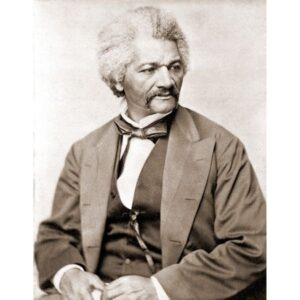
In our current world, many students disdain reading for any purpose, let alone pleasure. This concept would have been inconceivable to Frederick Douglass as he fought for the freedoms we all have today!
You can use this nonfiction narrative passage in a Civil War Unit, a narrative writing course, Black History Month curriculum, and really in ANY ELA or Reading class!
Here is an excerpt from this important historical nonfiction narrative:
But, alas! this kind heart had but a short time to remain such. The fatal poison of irresponsible power was already in her hands, and soon commenced its infernal work. That cheerful eye, under the influence of slavery, soon became red with rage; that voice, made all of sweet accord, changed to one of harsh and horrid discord; and that angelic face gave place to that of a demon.
Very soon after I went to live with Mr. and Mrs. Auld, she very kindly commenced to teach me the A, B, C. After I had learned this, she assisted me in learning to spell words of three or four letters. Just at this point of my progress, Mr. Auld found out what was going on, and at once forbade Mrs. Auld to instruct me further, telling her, among other things, that it was unlawful, as well as unsafe, to teach a slave to read.
Here is a link to the full chapter!
NONFICTION NARRATIVE & FICTION RESOURCES
Do you need help with reading test prep this year? This Distance Learning for use in Google Classroom(TM) Reading Comprehension Test Prep Lesson and Quiz ULTIMATE BUNDLE prepares middle and high school students for state exams and assessments by incorporating informational texts, nonfiction narrative literature, literary texts, and paired passages!
It includes 100 EASY-TO-TEACH lessons with DIGITAL worksheets, activities, writing responses, passages, and Common Core Style Test Prep QUESTIONS and ANSWERS in PDF format as well as Google Classroom Slides!
Just PRINT/ASSIGN and TEACH!!
Need more nonfiction narrative literature lessons and activities? Check out my store Kristin Menke-Integrated ELA Test Prep!

